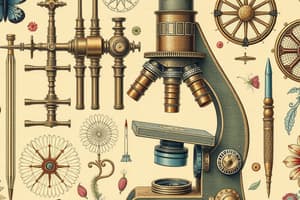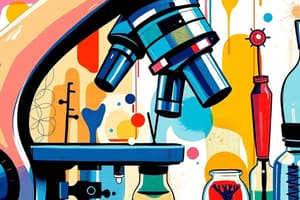Podcast
Questions and Answers
What is the primary function of the coarse adjustment knob in a compound light microscope?
What is the primary function of the coarse adjustment knob in a compound light microscope?
The coarse adjustment knob moves the body tube or stage in larger increments to bring the specimen into initial focus.
How does the illuminating condenser enhance the viewing of a specimen?
How does the illuminating condenser enhance the viewing of a specimen?
The illuminating condenser concentrates light onto the specimen, improving visibility.
Why is the fine adjustment knob preferred for high power or oil immersion objectives?
Why is the fine adjustment knob preferred for high power or oil immersion objectives?
The fine adjustment knob moves the stage or body tube in smaller increments to achieve sharp focus.
What part of the microscope is responsible for holding the specimen slide firmly in place?
What part of the microscope is responsible for holding the specimen slide firmly in place?
Explain the function of the iris diaphragm in a compound light microscope.
Explain the function of the iris diaphragm in a compound light microscope.
What is the purpose of the base in a compound light microscope?
What is the purpose of the base in a compound light microscope?
How does the revolving nosepiece contribute to the functionality of a microscope?
How does the revolving nosepiece contribute to the functionality of a microscope?
What is the magnification capability of the ocular lens in a compound light microscope?
What is the magnification capability of the ocular lens in a compound light microscope?
Flashcards are hidden until you start studying
Study Notes
Microscope Parts and Functions
- Mechanical Draw Tube: Holds the ocular lens, a small cylinder attached to the body tube.
- Body Tube: Connects the ocular lens to the revolving nosepiece.
- Coarse Adjustment Knob: Used for initial focusing, moves the body tube or stage in larger increments. Recommended for scanner or low power objective.
- Fine Adjustment Knob: Used for sharp focusing, moves the body tube or stage in smaller increments. Recommended for high power or oil immersion objectives.
- Arm: Supports the body tube and is used to carry the microscope.
- Revolving Nosepiece: Circular part connected to the body tube, holds the objective lenses.
- Stage: Platform where the specimen slide is placed, contains a hole for light to pass through the specimen.
- Stage Clips: Secure the specimen slide on the stage.
- Inclination Joint: Connects the arm to the pillar, allows tilting the microscope.
- Pillar: Supports the arm above the base.
- Base: Provides firm support for the entire microscope.
- Magnifying Ocular Lens (Eyepiece): Detachable cylinder on top of the draw tube, used for viewing the specimen. Typically magnifies 10x. May have a black line pointer.
- Objective Lens: Magnifies the specimen. Compound microscopes usually have three: low power (LPO), high power (HPO), and oil immersion (OIO). Some microscopes have an additional scanner objective. Scanner may replace OIO on some microscopes. Objectives are used in this order: scanner, LPO, HPO, and OIO.
- Illuminating Condenser: Concentrates light onto the specimen, located above the iris diaphragm. May have knobs for adjusting its position.
- Iris Diaphragm: Controls light passing through the specimen. Lever is moved back and forth to adjust.
- Mirror: Reflects light to the specimen slide and then reflects the image back to the eyes. Located below the stage, near the base.
Studying That Suits You
Use AI to generate personalized quizzes and flashcards to suit your learning preferences.




